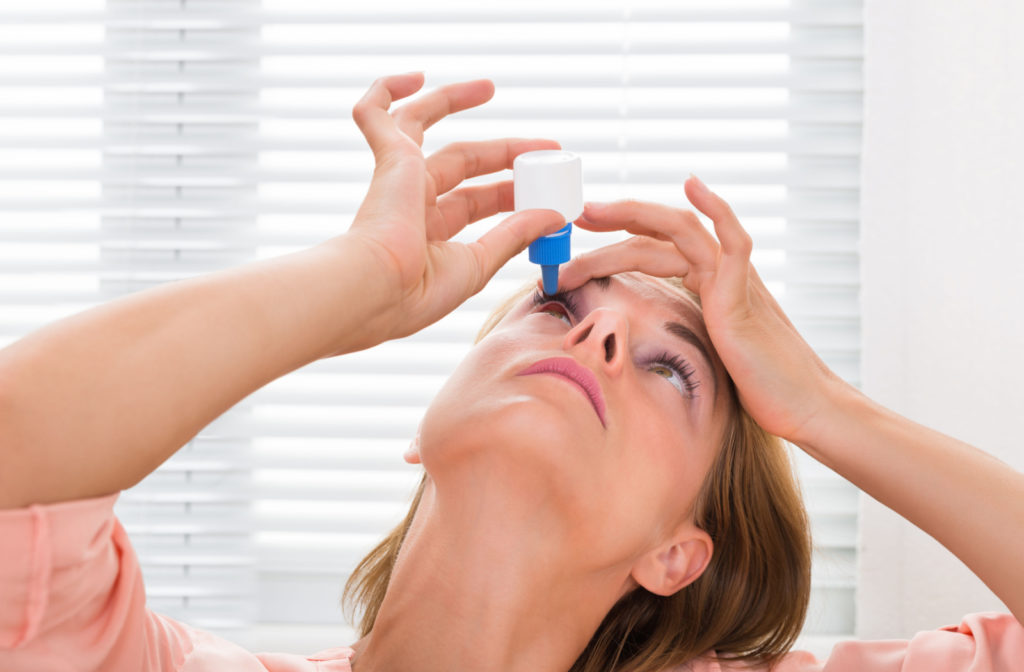Your glasses or contact lenses correct a refractive error to improve your vision. There are a few different refractive errors that can cause blurry vision, including myopia and astigmatism. Myopia and astigmatism are distinct vision issues, but it’s common to have both.
During your eye exam, your optometrist can perform tests to determine whether you need vision correction for myopia, astigmatism, or both.
What Is Myopia?
Myopia, also called nearsightedness, occurs when you can see clearly up close, but distant objects appear blurry. It develops when the eye grows too long or the cornea is too curved. As a result, light entering your eye is focused in front of the retina instead of directly on it, making distant objects appear blurry and out of focus.
Children typically develop myopia between the ages of 6 and 12, and it worsens until early adulthood. Overall growth slows around age 20, and eyesight will stabilize around the same time.
Common symptoms of myopia include:
- Difficulty seeing at a distance
- Headaches
- Eye strain
In children, caregivers should watch for behavioral cues pointing to myopia, including:
- Sitting too close to the television
- Leaning toward computer or tablet screens
- Holding books close to their face
- Frequent squinting
What Is Astigmatism?
Astigmatism is a common eye condition where the curvature of the cornea or lens is imperfect, and the eye is shaped like an egg or American football. There are 2 basic types of astigmatism:
- Horizontal astigmatism, where the eye is wider than it is tall
- Vertical astigmatism, where the eye is taller than it is wide
Both types cause distorted or blurry vision at all distances.
Symptoms of astigmatism can include:
- Eye strain
- Headaches
- Squinting to see at varying distances
- Difficulty seeing at night
You can develop astigmatism at any age, in one eye or both, and it can worsen or improve over time. While it’s believed to be primarily caused by genetics, other factors may contribute, including:
- Keratoconus
- Eye injury
- Eye surgery complications
Can You Have Both Myopia & Astigmatism at the Same Time?
It’s common for people to have both myopia and astigmatism. The two conditions can often occur together, making daily activities like driving, reading road signs, participating in class, and playing sports difficult without vision correction.
Correction for Myopia & Astigmatism
If you have both myopia and astigmatism, your optometrist may recommend a combination of approaches to correct both refractive errors, like prescription glasses or contact lenses. In some cases, refractive surgery, such as LASIK, can correct both conditions and reduce your reliance on prescription eyewear.
Glasses & Contact Lenses
Corrective lenses are the most common method to address myopia and astigmatism. Eyeglasses provide straightforward vision correction for both refractive errors, but depending on the severity of your astigmatism, you may require specialized toric or rigid gas-permeable contact lenses.
Orthokeratology
Orthokeratology, or ortho-k, is a specialized, custom-made contact lens worn overnight to gently reshape your cornea as you sleep. It helps correct the refraction error caused by astigmatism and an overly curved cornea caused by myopia. When you remove the lenses in the morning, you may notice better vision and not need your glasses or contact lenses during the day.
The effect is temporary, however. If you stop wearing these contacts, your vision will return to normal.
Laser Surgery
For a longer-term solution, laser surgery like LASIK or PRK can surgically reshape the cornea to change how light refracts in the eye. Various procedures are available, and your vision problem and eye care needs will determine the best approach for you.
Some people may still need glasses or contacts after surgery. And while laser eye surgery permanently changes the shape of your cornea, your eyes will still change with age, and vision issues may crop up later.
Myopia Control to Slow Progression
Controlling myopia can help reduce the risk of developing high myopia and related eye conditions like:
- Myopic macular degeneration
- Retinal detachment
- Glaucoma
- Cataracts
Several myopia control methods are available to help slow myopia progression in children, which is crucial for reducing the risk of complications and potential vision problems in the future.
Soft Contact Lenses
Specialty soft contact lenses have been shown to slow the elongation of the eye. Research suggests that inducing defocus on the peripheral retina can help slow down myopia progression in children, meaning the contacts intentionally create a slight blur in the peripheral vision while keeping the central vision clear to signal the eye to stop growing.
Ortho-K
Ortho-k helps correct vision and has also been shown to slow myopia progression in children and adolescents by 50%. The exact reason how they achieve this is unknown, but it’s generally accepted it’s because they change the way light is reflected in the eye.
Atropine Eye Drops
Low-dose atropine eye drops have proven effective in slowing myopia progression in children’s eyes, and they’re a simple method to use. With one drop in each eye every night before bedtime, low-dose atropine can help slow your child’s eye growth.
The exact mechanism behind how atropine works to achieve this is not fully understood, but several theories have been proposed.
One theory is that atropine dilates the pupils and temporarily paralyzes the focusing muscles inside the eye. By doing so, atropine may help reduce strain on the eye and prevent further elongation.

Correct Your Refractive Error
If you have both myopia and astigmatism, you’re not alone. The doctors at Total Vision Solana Beach can help you manage both conditions through various approaches, including glasses, contacts, refractive surgery consultations, and myopia control.
Schedule an appointment for regular eye exams to monitor vision changes and protect your eye health.



